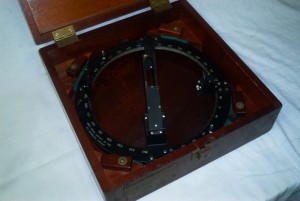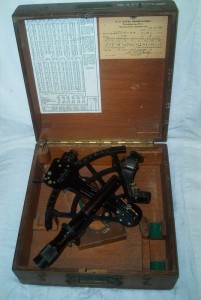Bearing Circle
The bearing circle is not a piece of electronic equipment. It includes an aperture, sight wire, and a mirror. The bearing circle is laid on the wing repeater and rotates easily. A buoy or landmark is sighted through the bearing circle and the bearing scale is seen in the mirror. Since the wing repeater is driven from the gyrocompass, the bearing seen is the true bearing for the vessel.
On a chart, the reciprocal (differing by 180 degrees) bearing from two or more of the buoys or land marks can be drawn; own vessel is at the intersection of the lines.
The Eastern Specialty Company – Mark 1 Model 2
Manufactured by: The Eastern Specialty Company
Model: Mark 1 Model 2
Sextant
A sextant is a measuring instrument generally used to measure the angle of elevation of a celestial object above the horizon. Making this measurement is known as sighting the object, shooting the object or taking a sight. The angle, and the time when it was measured, can be used to calculate a position line on a nautical or aeronautical chart. A common use of the sextant is to sight the sun at noon to find one's latitude. Held horizontally, the sextant can be used to measure the angle between any two objects, such as between two lighthouses, which will, similarly, allow for calculation of a line of position on a chart.
The specific feature that let the sextant displace the astrolabe is that celestial objects are measured relative to the horizon, rather than relative to the instrument. This allows much better precision. Since the measurement is relative to the horizon, the measuring pointer is a beam of light that reaches to the horizon. The measurement is thus limited by the angular accuracy of the instrument and not the sine-error of the length of a viewing pointer, as it is in an astrolabe.
The horizon and celestial object remain steady when viewed through a sextant, even when the user is on a moving ship. This occurs because the sextant views the (unmoving) horizon directly, and views the celestial object through two opposed mirrors that subtract the motion of the sextant from the reflection.
The sextant is not dependent upon electricity (unlike many forms of modern navigation) or anything human-controlled (like GPS satellites). For these reasons, it is considered an eminently practical back-up navigation tool for ships.
David White Co.- Mark II
Manufactured by: David White Co.
Model: Mark II


